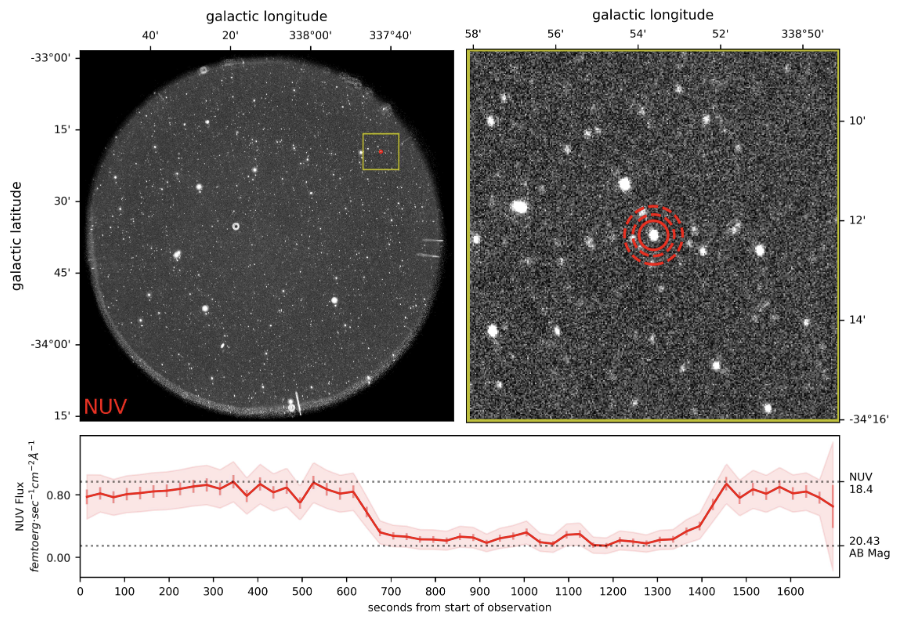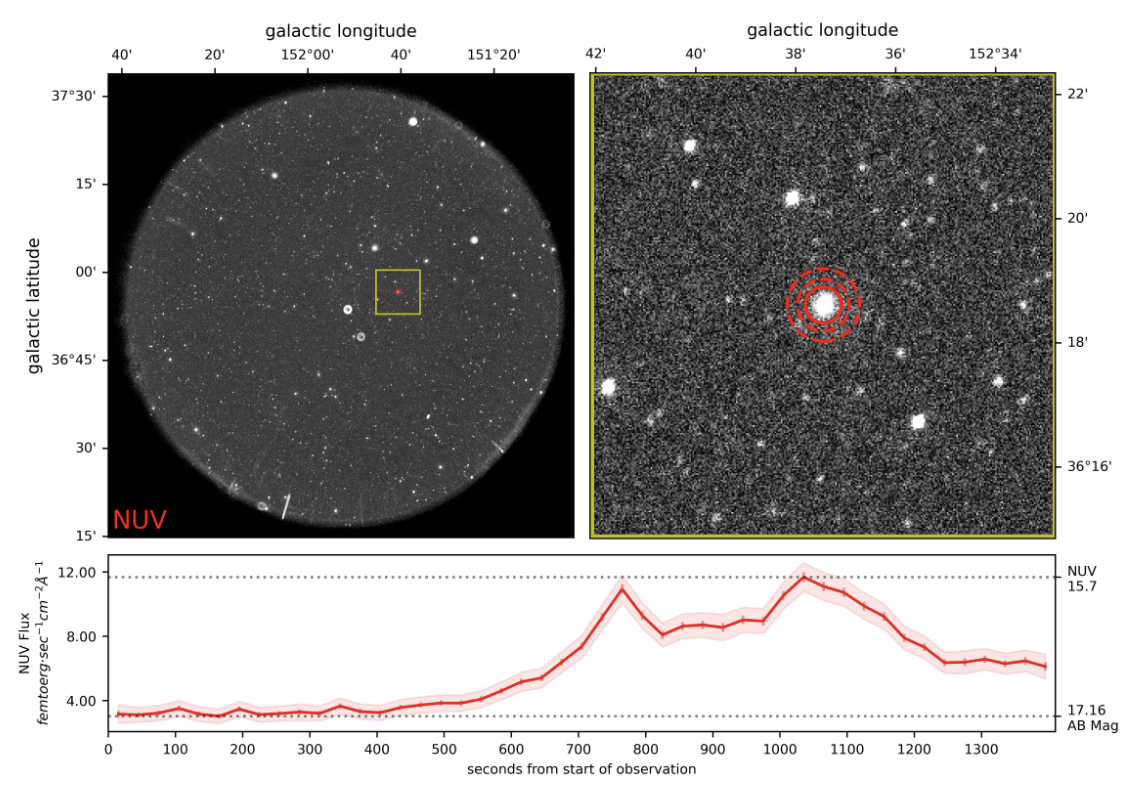Mission Overview
A Catalog Of Ultraviolet Variables Observed By GALEX With Sub-Minute Resolution ("GFCAT")
Primary Investigator: Chase Million
HLSP Authors: Scott W. Fleming, Chase Million
Released: 2023-06-29
Updated: 2023-06-29
Primary Reference(s): Million et al. 2023
DOI: 10.17909/8d57-1698
Citations: See ADS Statistics
Slideshow
Overview
GFCAT is the result of a systematic search for intra-visit variability using calibrated GALEX photon events to construct lightcurves at 30-second time resolution. Using the gPhoton2 software package, a semi-automated search for variable objects was conducted using calibrated photon events from every GALEX visit with at least 500 seconds of exposure time. This is equivalent to searching all visits from the Medium Image Survey ("MIS") or longer exposure lengths. Source detection was run on the resultant time series of images, and aperture photometry applied in both FUV (where available) and NUV bands using five photometric apertures. Variable objects were first identified through automated detection and then by-hand screening. The final product consists of 1959 lightcurves from 1426 unique sources. The lightcurves are constructed using five aperture sizes (9, 12.5, 17.5, 25, and 35 arcseconds), stored in separate FITS files. Each GALEX eclipse is analyzed independently, thus, variable objects observed more than once will have more than one set of lightcurves created. Four catalogs are also provided: an object catalog containing information about the unique objects, a visit catalog containing information about the vetted variable objects in each GALEX visit, an eclipse catalog containing those sources identified as looking like eclipsing objects through visual inspection, and a flare catalog containing those sources identified as looking like flares. GFCAT should not be considered suitable for general population studies or statistics: the goal was to locate as many intra-visit variables as possible in the GALEX photon database, at the expense of analyzing selection effects.
Data Products
Note
The eclipse e13794 was collected in a special, rarely-used GALEX observing mode in which the highest possible time resolution of the photon counting events was retained, rather than the 0.005-second time resolution typically used. It therefore requires special processing in order to produce light curves and QA plots, which is why the products for this eclipse are different from the others. The HLSP team is confident that the source at RA, Dec = [4.049198,-39.45633] is, in fact, time variable because it shows similar temporal morphology in both bands, and the others stars in the field do not have significant time-varying behavior. But analysis of this specific observation with GALEX may require special care and handling.
Object Catalog
The GFCAT object catalog contains one row per unique source contained in GFCAT. The unique identifier 'gfcat_objid' pivots on the column of the same name in the visit catalog for easy cross-referencing. Column names and definitions are available in the README file.
Visit Catalog
The GFCAT visit-level table contains one row per lightcurve identified as consistent with astrophysical variability. Each lightcurve corresponds to one "source-visit": a single observation of a specific source. Unless otherwise noted, all measurements in this table were performed using a circular aperture with a radius of 17.5 arcseconds centered on the positions indicated by `ra` and `dec`. Some time values are in "GALEX Time" scale where specified in the column description found in the README file. This is equivalent to UNIX Time minus 315964800, in seconds (i.e. GALEX TIME = UNIX TIME - 315964800). Column names and definitions are available in the README file.
NOTE: To improve human-readability of the table, two dashes "--" have been used as a missing-value placeholder. In many data-processing applications, this value will need to be specified as a special constant or replaced with a valid special constant before analysis.
Eclipsing Object Catalog
The GFCAT table of candidate eclipsing objects contains one row for each lightcurve (source-visit) manually identified as morphologically consistent with a stellar eclipse. Its contents are a strict subset of the rows of the GFCAT Visit Catalog, so all column definitions can be found in the Visit Catalog description. Column names and definitions are available in the README file.
Flare Catalog
The GFCAT table of candidate flares contains one row for each lightcurve (source-visit) manually identified as morphologically flare-like. This table inherits many columns from the GFCAT Visit Catalog, so definitions for those columns can be found in the Visit Catalog description. Columns unique to the Flare Catalog are described in the Flare Catalog section of the README file, which should be consulted for names and definitions for all the available columns.
NOTE: All fluence and energy values are recorded in base-10 log scale. For instance, a value of 32 in the energy_NUV column means 1032 ergs.
File Name Formats
The catalog files have the following file naming convention:
hlsp_gfcat_galex_imaging_<type>-cat_fuv-nuv_v1_table.csv
where:
- <type> = the type of catalog, one of "eclipse", "flare", "object", or "visit"
The lightcurve files have the following file naming convention:
hlsp_gfcat_galex_imaging_<eclipse>-gfcat-<object>_<band>_v1_30s-photom-<aperture>.fits
where:
- <eclipse> = the GALEX eclipse ID, e.g., "e10830"
- <object> = the GFCAT object ID, e.g., "j163913.6p413956.6"; note that '+' is replaced with 'p' and '-' is replaced with 'm' in the file names, the FITS headers have both the GFCAT ID with the symbols and the file name version as keywords
- <band> = the wavelength band, one of "fuv" or "nuv"
- <aperture> = the photometric aperture used, in arcseconds, one of "9", "12.5", "17.5", "25", or "35"
Data file types:
| _30s-photom-*.fits | Lightcurve file. |
| _table.csv | Catalog file. |
| _qa.jpg | Quality Assurance plot. |
Data Access
You can download the GFCAT light curves and preview plots using this shell script, which contains curl commands to download each file. The total size of the entire collection is approximately 9 GB.
| Bulk Download Script | Size After Downloaded |
|---|---|
| hlsp_gfcat_galex_imaging_all_fuv-nuv_v1_bulkdl.sh | ~9 GB |


